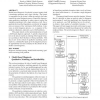Free Online Productivity Tools
i2Speak
i2Symbol
i2OCR
iTex2Img
iWeb2Print
iWeb2Shot
i2Type
iPdf2Split
iPdf2Merge
i2Bopomofo
i2Arabic
i2Style
i2Image
i2PDF
iLatex2Rtf
Sci2ools
AIA
2006
2006
Speeding Up Model-based Diagnosis by a Heuristic Approach to Solving SAT
Model-based diagnosis of technical systems requires both a simulation machinery and a logic calculus. The former is responsible for the system's behavior analysis, the latter controls the actual diagnosis process. Especially when pursuing qualitative simulation, it makes sense to realize the simulation machinery with a logic calculus as well. Say, a qualitatively described hypothesis can directly be mapped onto an instance of the well-known SAT problem. Likewise, an entire diagnosis process, i. e., a sequence of hypothesis refinements, represents a set of SAT problems. This paper reports on the operationalization of such a SAT-based diagnosis approach. A specific characteristic here is the idea to exploit an ordering of the logical formulas according to their likeliness of being satisfiable. This idea is new in the context of qualitative reasoning, and it leads to a considerable speed up of the diagnosis process. Its applicability has been evaluated in the domain of hydraulic cir...
| Added | 30 Oct 2010 |
| Updated | 30 Oct 2010 |
| Type | Conference |
| Year | 2006 |
| Where | AIA |
| Authors | Benno Stein, Oliver Niggemann, Theodor Lettmann |
Comments (0)

